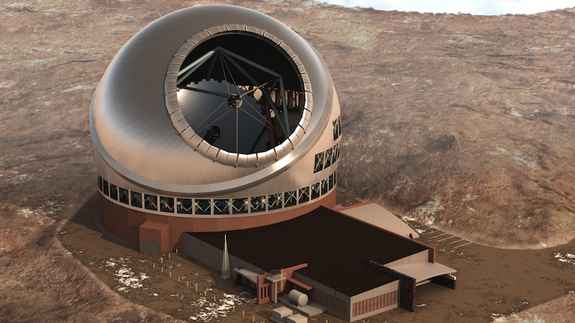A ground breaking ceremony for what will be one of the word’s most advanced observatories was disrupted Tuesday by Native Hawaiian protesters and others opposed to the construction of the Thirty Meter Telescope on Mauna Kea.
More than 50 protesters blocked access near the mountain’s summit and greeted vans carrying dozens of attendees from five countries with chants and hula.
Hawaiian activists have been fighting the Thirty Meter Telescope for the last four years in court, but have so far been unsuccessful in stalling plans. Opponents of the $1.4 billion multinational project say the construction will desecrate a place many native Hawaiians use for burials, the interment of umbilical cords (called “piko”), as well as traditional celestial observation ceremonies.
“As much as I’m standing for the mauna (mountain) and all the people, today is personal for me,” Kauʻi Peralto, a Hawaiian cultural educator at Standford University, told the San Francisco Chronicle. “We take our piko to sacred places, so I’m standing for all my family and friends who have piko on that mountain. And when the groundbreaking starts, we don’t know how many will be dug up, because we bury them in secret.”
As Peralto organized protestors in California, her former mentor and teacher, Pua Case, organized the protest on Hawaii’s Big Island. Case’s fight — including Tuesday’s protest — has been assisted by a number of Hawaiian cultural practitioners and educators, including Kamahana Kealoha.
“The TMT is an atrocity the size of Aloha Stadium,” Kealoha said in a statement. “It’s 19 stories tall, which is like building a sky-scraper on top of the mountain, a place that is being violated in many ways culturally, environmentally and spiritually.”
Students at the University of Hawaii also voiced their concerns over the impending construction.
“This has been an issue for us because the momentum of their decision has been in full force, but they haven’t made the information public for a dialogue,” Pulama Long, a Hawaiian Studies major, told the university’s student paper Kaleo. “It’s a huge decision that affects a lot of people made by a small group.”
Universities and organizations from Japan, the United States, China, Canada and India are all contributing funding to the project. Despite the protest, construction is still expected to begin in April of 2015; the telescope is set to be completed by 2022.
Agencies/Canadajournal

 Canada Journal – News of the World Articles and videos to bring you the biggest Canadian news stories from across the country every day
Canada Journal – News of the World Articles and videos to bring you the biggest Canadian news stories from across the country every day


A partnership of European countries plan to build the European Extremely Large Telescope, which would have an 138-foot mirror. The group is considering sites in Argentina, Chile, Morocco and Spain. It plans to decide on a location next year and be able to host its first observation in 2018.
“Hubble Telescope placed 559 kilometers above our planet earth, and the scheduled James Webb Telescope to be placed 1.5 million kilometers from earth (L2point) obviate the need for land based telescopes which are limited by our atmospheric interference. Better to pool the money and build another Hubble in space than these land based ones.” – R Murty K from New Jersey.
As it is, there’s already 12 telescopes on the summit and a few more on Haleakala, Maui. It’s way more than we agreed to. Possible solution would be to remove many of the other smaller ones and place the huge TMT onto where they are now. We, Hawaiian Kingdom subjects, object to the further desecration of our mountain and need the U.S. to de-occupy our nation-state since it has no treaty of annexation and they refuse to listen to us.
The groundbreaking ceremony and blessing never took place on October 7, 2014, because they were completely halted by protesters for cultural and spiritual reasons, as well as the legal status of Hawaiʻi as an occupied state. There is no treaty of cession to transfer Hawaiian sovereignty to the United States. The Newlands Resolution (1898), Organic Act (1900), and Admission Act (1959), are domestic laws of U.S. Congress which have no power under the U.S. Constitution to unilaterally annex a foreign country such as Hawaiʻi.